| Columns Retired Columns & Blogs |
PSB Alpha loudspeaker Measurements
Sidebar 2: Measurements
"A small, two-way, ported design," says the Alpha's plot of impedance amplitude and phase (fig.1). The port tuning is revealed by the amplitude saddle at 50Hz, and there is some sort of resonant problem just above 200Hz, hinted at by the glitch in both traces. The drop below 6 ohms between 120Hz and 350Hz implies that mid-fi receivers need not apply for the job of driving this little PSB, though it is actually a very easy load in the midrange and above.
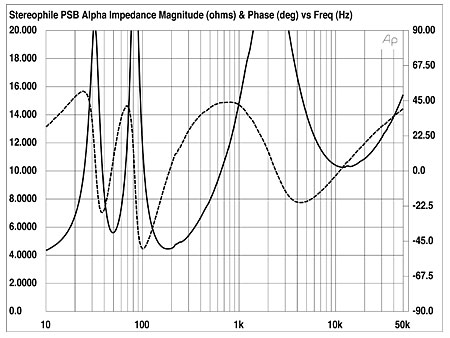
Fig.1 PSB Alpha, electrical impedance (solid) and phase (dashed). (2 ohms/vertical div.)
To the left of fig.2 can be seen the individual responses of the woofer (blue trace) and the rear-firing port (red), taken with the microphone almost touching the diaphragm, and centered in the port opening, respectively. The port output is centered on 45Hz or so, which by itself might imply reasonable bass extension. However, the plotting of the levels of these nearfield responses is of necessity arbitrary compared with the full-range response to their right; I suspect from JE's comments that the bass region is actually shelved down a little. Put the speakers near a room boundary, however, and the lows will be usefully reinforced, just as he found, giving a more balanced response in-room, overall.
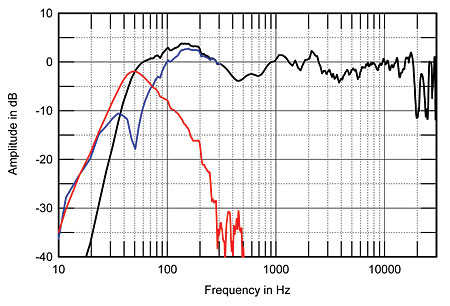
Fig.2 PSB Alpha, anechoic response on tweeter axis at 45", averaged across 30° horizontal window and corrected for microphone response, with the nearfield woofer (blue) and port (red) responses plotted below 300Hz and 500Hz, respectively, as well as their complex sum, taking into account acoustic phase and distance from the nominal farfield point, plotted below 300Hz.
To the right of fig.2 is shown the Alpha's quasi-anechoic response across a 30° horizontal window centered on the tweeter axis (as near as could be figured, given the nonremovable grille cloth). Quite flat through the treble, there is some on-axis prominence in the low treble which could lead to a somewhat aggressive balance overall. This presumably is one of the reasons why JE preferred the speakers pointed straight ahead rather than toed-in to the listening seat. This is confirmed in fig.3, which shows how the speaker's balance changes as the listener moves off-axis to the side. (Only the differences due to the changes in listening position are shown, which is why the on-axis response is depicted as a straight line in this graph.) The woofer starts to get more directional near the top of its passband, which compensates to some extent for the on-axis prominence in this region.
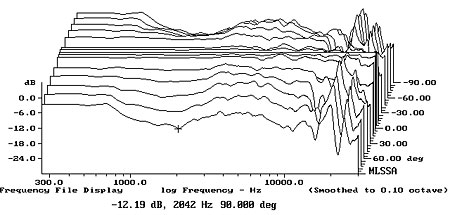
Fig.3 PSB Alpha, lateral response family at 45", normalized to response on tweeter axis, from back to front: differences in response 90°–5° off-axis, reference response, differences in response 5°–90° off-axis.
Similarly, the Alpha owner can reduce the low-treble edge by modifying the height of the speakers. This can be seen in fig.4, which shows the differences in balance to be expected at different listening heights. Sit too high and a large suckout appears in the crossover region, which would make the sound both rather lifeless and too threadbare. But move below the tweeter axis, and the on-axis treble emphasis will be usefully reduced, without an apparent loss elsewhere.
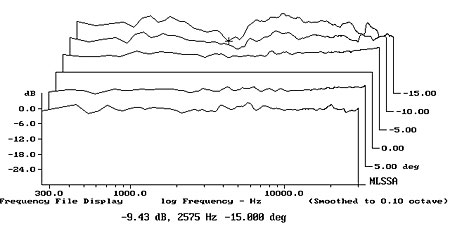
Fig.4 PSB Alpha, vertical response family at 45", normalized to response on tweeter axis, from back to front: differences in response 15°–5° above axis, reference response, differences in response 5°–10° below axis.
The Alpha's step response (fig.5) indicates that both drive-units are connected with the same positive acoustic polarity, with some ultrasonic ringing from the tweeter. Fig.6 examines how the speaker's balance changes as this impulse decays. The treble offers some hash in the top audio octave but is otherwise clean, an excellent result for such an inexpensive unit. The woofer, however, does have some sort of problems around 1kHz and just above 2kHz, these coincident with the on-axis prominence in this region (fig.2). Though this probably contributes to the on-axis edginess, I've seen much worse behavior from more expensive speakers.
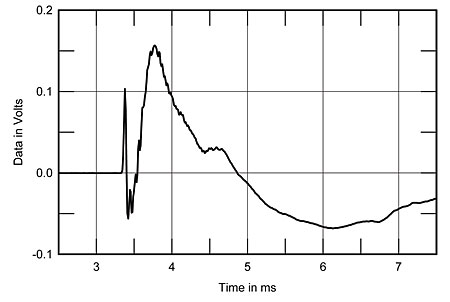
Fig.5 PSB Alpha, step response on tweeter axis at 45" (5ms time window, 30kHz bandwidth).
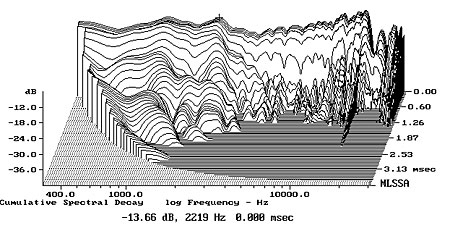
Fig.6 PSB Alpha, cumulative spectral-decay plot at 45" (0.15ms risetime).
Finally, as the sidewalls of the Alpha sound quite honky to the "knuckle-rap" test, I examined the behavior of the cabinet with a simple accelerometer, as explained in June (pp.205–207). Fig.7 shows a waterfall plot for the accelerometer output when taped horizontally midway up the sidewall. As well as some output at the bass tuning frequency, two very strong resonant modes can be seen at 242Hz and 406Hz. These both coincide with slight glitches in the PSB's impedance plot (fig.1) and could reasonably be expected to add a degree of lower-midrange congestion to the Alpha's sound. Overall, however, this is excellent measured performance considering the PSB Alpha's price—not much more than a family's weekly grocery bill.—John Atkinson
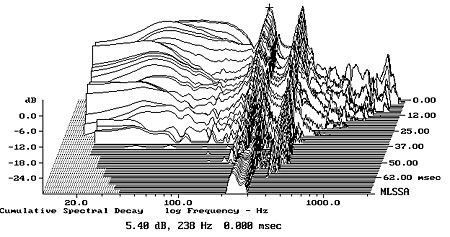
Fig.7 PSB Alpha, cumulative spectral-decay plot calculated from the output of an accelerometer fastened to the cabinet's side panel (MLS driving voltage to speaker, 7.55V; measurement bandwidth, 2kHz).
- Log in or register to post comments




































